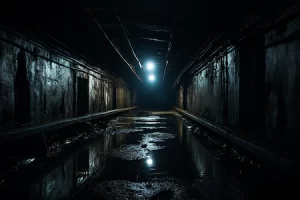Inside the Hidden Tunnels of Savannah

On the surface, Savannah is known for its architectural beauty, historical significance, and spiritual activity. However, many do not know that much of the same is happening below ground. A series of tunnels lay beneath some of downtown Savannah’s most commonly visited buildings.
These tunnels have been used throughout the centuries for nefarious activities such as slave trading, shanghaiing drunks sailor, and transporting dead bodies. Take away the beautiful architecture, and Savannah remains much the same—a city rich with history and full of ghosts.
Why are there tunnels underneath Savannah?
A series of haunted tunnels run underneath much of Savannah. They were once used to transport slaves to freedom, kidnapped sailors, and corpses.
The spirits of these forsaken souls still haunt the tunnels today. They gather beneath The Pirates House, Forsyth Park, First African Baptist Church, and more. The tunnels sprawl out, with many leading to the river or the sea, underneath the city and are mostly forgotten about.
Keep reading to learn more about these dark and nefarious tunnels. For a more upfront and personal experience with the tunnels, take a ghost tour with US Ghost Adventures on your next visit to Savannah.
Tunnels Underneath Savannah
The tunnels underneath Savannah are a strange mixture of fact and fiction. They exist beneath the surface of many establishments, but very little fun has ever been had down there. Though it’s not entirely known why the tunnels were built, what is known is they didn’t always serve such a sinister purpose.
Let’s take a look at some of these tunnels and their conjoining ghost stories.
The Pirates House Tunnel
The most well-known of the various interconnecting tunnels of Savannah is located underneath The Pirates House. Built in 1753, The Pirates House was once a tavern and inn for visiting sailors to the newly founded port city. As time passed, it became a familiar meeting spot for pirates and other unwanted seafaring men.
Author Robert Louis Stevenson once visited the famed inn, which inspired him to write his classic pirate novel Treasure Island. The bar’s patrons have been well taken care of throughout its 270-year history. But things were not always so simple at The Pirates House.
The stories go that these tunnels were used to “Shanghai” unsuspecting sailors. These sailors would fully imbibe themselves upon sitting at the bar, happy to be on land and near pretty women and alcohol. After a few too many drinks, they would mysteriously find themselves back in the middle of the ocean and on an unfamiliar ship! It is said that they would be dragged through the underground tunnels of the tavern and taken out to sea, pawns in a kidnapping scheme that brought money to some and disasters to others. This was a common practice in the 18th and 19th centuries, and in a major port city such as Savannah was not unheard of.
Today many say you can hear the moaning and wailing of these captured seamen. They share the area with the spirits of the unruly pirates haunting the bar above around. No one seems to know where the tunnel is, but all are certain of its existence.
The First African Baptist Church Tunnel
The tales of prohibition-era alcohol transportation techniques often accompany these stories of kidnapped sailors. While these very likely may be true, it appears the larger truth to these tunnels is that they were built to strengthen the institution of slavery.
Slaves would secretly be brought through the tunnels, as slavery was initially illegal in colonial Georgia, and to their holding areas. Later they were utilized by those looking to escape the horrors their descendants went through.
Many of these tunnels were used as part of the Underground Railroad during the civil war and the years prior. The most crucial evidence of this can be found below the First African Baptist Church. The First African Baptist Church was first organized in 1773, making it older than America itself. After British occupation in Savannah ended in 1782, their first pastor left for Jamaica to escape slavery.
In 1859, the church was constructed along with the first black Sunday school in the United States. It was during this time that the tunnels underneath it were most active. Many slaves sought to escape the South during the civil war and traveled north through tunnels known as the Underground Railroad.
Small holes mark the floor of First African Baptist. They are part of the shape of a BaKongo Cosmogram, a circular pattern designed to appease the spirits. The holes in the design allowed escaping slaves to hide from persecution safely.
Odd sounds are heard down there, much like the tunnels at The Pirate House. A local historian for the church stated that she “is too chicken” to go down in them even. Othe
Forsyth Park
The great yellow fever epidemics of the 19th century did not spare Savannah. In 1876 the mosquito bread disease left the city crippled and overrun with corpses. One thousand sixty-six people died in this great plague, and the local healthcare institution, Candler Hospital, was overwhelmed.
Tunnels were constructed underneath nearby Forsyth Park to transport the dead outside of city limits, as it was believed corpses helped spread the disease. Stories are told of spirits below the grounds and inside Candler Hospital.
These tunnels were constructed in 1884, eight years after the last yellow fever epidemic. But they lead to the hospital’s morgue, a death-filled place. All know them to harbor the spirits of the city’s past.
The tunnels beneath Savannah are unseen to those above ground but not unknown. Tours often visit the areas where they are located and are the best way to hear these stories. To hear for yourself, take a guided tour with US Ghost Adventures. Head to our website for further information and details on booking.
Sources:
https://www.wtoc.com/story/15149339/under-our-noses-savannahs-tunnels/
https://www.savannahmagazine.com/beneath-the-surface/
https://thepirateshouse.com/history/
https://firstafricanbc.com/history.php
https://www.georgiaencyclopedia.org/articles/history-archaeology/slavery-in-colonial-georgia/

